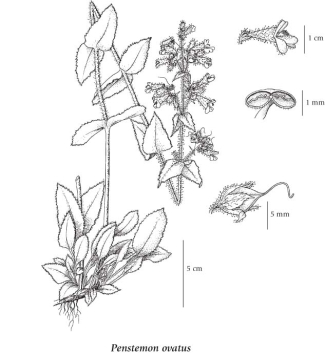Penstemon ovatus Douglas ex Hook.
broad-leaved penstemon (eggleaf beardtongue)
Plantaginaceae (Mare's-tail family)
(Previously in Scrophulariaceae)
Introduction to Vascular Plants
broad-leaved penstemon (eggleaf beardtongue)
Plantaginaceae (Mare's-tail family)
(Previously in Scrophulariaceae)
Introduction to Vascular Plants
Species Information
General:
Perennial herb from a woody stem-base; stems several, clustered, ascending to erect, 30-100 cm tall, usually smooth below, spreading-coarse-hairy in the inflorescence.
Leaves:
Opposite, distinctly saw-toothed, bright green, spreading-hairy especially along the midrib beneath or nearly smooth; basal leaves egg-shaped to broadly lanceolate, 6-16 cm long, 2-5 cm wide, stalked, the stalks about as long as the blades; stem leaves well developed, almost as long as the basal leaves, more triangular egg-shaped above, unstalked, clasping-based.
Flowers:
Inflorescence a leafy-bracted, rather open, terminal cluster of several whorls of stalked flowers; corollas deep blue, tubular, 1.5-2.2 cm long, 2-lipped, the lower lip longer than the upper lip, glandular-hairy on the outside, hairy inside at the throat; calyces 3-5 mm long, somewhat glandular-hairy, 5-lobed, the lobes nearly distinct, lanceolate to narrowly egg-shaped, slightly papery-margined if at all, pointy-tipped; fertile stamens 4, the anthers smooth except for the often bristle-toothed sutures; sterile stamen bearded toward the scarcely expanded, curved tip.
Fruits:
Capsules, 4-6 mm long; seeds numerous, 1-1.5 mm long.
Illustration

If more than one illustration is available for a species (e.g., separate illustrations were provided for two subspecies) then links to the separate images will be provided below. Note that individual subspecies or varietal illustrations are not always available.
Illustration Source: The Illustrated Flora of British Columbia